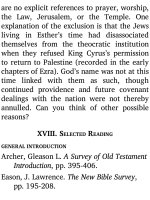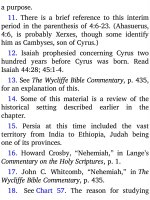Jensens survey of the old testament adam 450
Bạn đang xem bản rút gọn của tài liệu. Xem và tải ngay bản đầy đủ của tài liệu tại đây (117.46 KB, 4 trang )
D. STRUCTURE OF ROMANS
The next step in survey study is to look for
groups of segments according to content or
any turning point in the book. Do not refer
to the outlines on Chart 63 until you have
rst tried to arrive at your own outlines.
Even if you do not arrive at a complete
outline for the book, the time spent here in
independent study is well spent, for you will
begin to get acquainted more intimately
with what Paul was writing as you try to
discover how he wrote those truths. This is
the search for structure, or organization, of
the book.
Try answering these questions on the basis
of your survey of the twenty segments of
Romans:
1. What is the rst segment about? In
what ways does it serve as a prologue
(introduction) to the book?
2. Paul’s letters are composed mainly of
doctrinal and practical passages. Which
comes rst in Romans? Where does the
concentration of the second kind of passage
begin? How is the opening sentence of this
second kind a clue to what follows in the
division?
3. The last two segments (15:14-33 and
16:1-27) make up the epilogue. How do
they conclude the letter? What are the last
three verses of the letter?
4. Now you have viewed the four main
divisions of Romans: prologue; doctrinal;
practical; epilogue. Where are they identi ed
on Chart 63?
5. Where in the epistle does Paul write
much about sin and judgment? about
justification? about Israel?
6. Try to group the segments between
1:18 and 11:36 according to similar content.
These groups are called sections. Is there a
logical progression of general doctrinal
content in the sequence of the sections? If
so, what is it?
7. Before referring to the outlines on
Chart 63, survey the segments and sections
of Romans some more.
E. SURVEY CHART OF ROMANS
Observe on Chart 63 that the prologue is
made up of three parts: salutation; personal
testimony; and introduction of the theme.
Locate these in the Bible text.
The
rst eleven chapters are mainly
doctrinal. In those chapters Paul presents the
great truths of the gospel. What are the
main doctrines involved? How does the
doctrinal division (1:18—11:36) end? Is that
a clue that a change of subject follows?
The remaining chapters, 12-16, are mainly
practical. In those chapters Paul shows the
practical working out of the doctrines taught
in chapters 1-11. Read Philippians 2:12-13
for what Paul writes about working out
one’s salvation.
There is an ascending progression of
subject in the sections of 1:18—11:36,
shown by the arrow. The progression moves
from the wrath of God (God’s holiness in
condemning sin) to the glory of God (Gods
glory the object of service). Study the other
parts of the outline as they t into this
progression. From the outline of 12:1—
15:13 note also what should be the ultimate
object of all Christian service.
Though the practice of Christianity may
involve the most menial of tasks, all such
practice is placed by the Bible on a very
high plane. Observe how the practical









